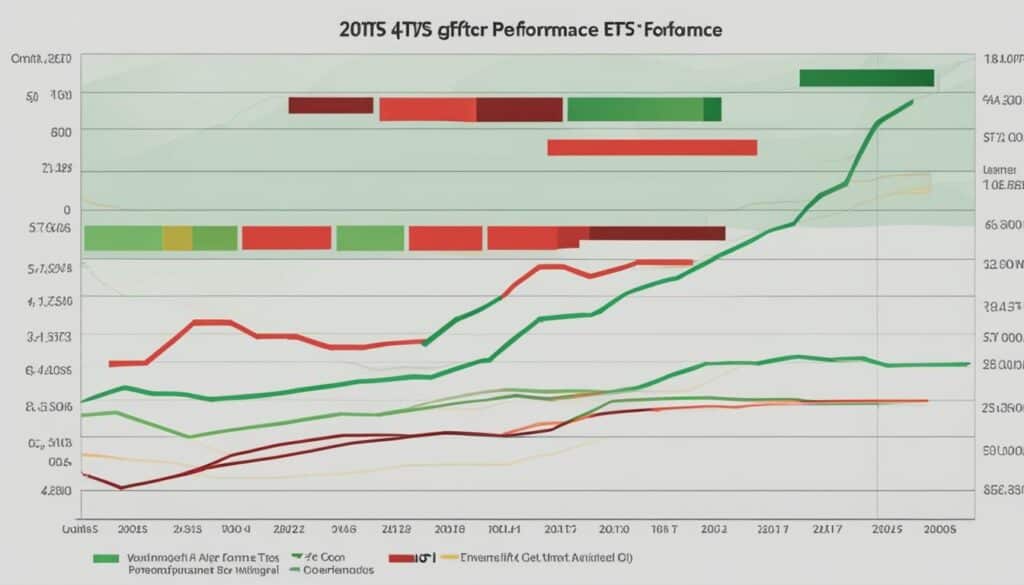Investors are constantly seeking ways to stabilize their portfolios and mitigate risk. One effective strategy is incorporating bond ETFs into their investment approach. Bond ETFs offer exposure to a diversified portfolio of bonds, providing stability and income potential. By utilizing bond ETFs, investors can maintain a balanced and well-rounded investment approach, which can help reduce the impact of market volatility.
Key Takeaways:
- Bond ETFs can help stabilize a portfolio and mitigate risk.
- They offer exposure to a diversified portfolio of bonds.
- Bond ETFs provide income potential and a balanced investment approach.
- Investors should consider factors such as interest rate risk and credit risk.
- Select bond ETFs that align with your investment goals and risk tolerance.
Understanding Bond ETFs
Bond ETFs are investment vehicles that trade on stock exchanges and offer exposure to a diverse range of fixed-income securities. These securities include government bonds, corporate bonds, and municipal bonds, among others.
Bond ETFs provide investors with the opportunity to gain exposure to the fixed-income market without having to purchase individual bonds, making them a convenient and cost-effective option. They also provide liquidity, as they can be bought and sold throughout the trading day, allowing investors to easily adjust their positions.
Bond ETFs offer diversification by investing in a variety of fixed-income securities from different issuers and sectors. This diversification helps to spread the risk and reduce the impact of any individual bond defaulting.
Bond ETFs can be particularly attractive to investors looking for income potential. These ETFs generate income through regular interest payments from the underlying bonds, providing a steady stream of cash flow.
By combining the benefits of diversification, liquidity, and income potential, bond ETFs offer a compelling investment option for investors looking to stabilize their portfolios and gain exposure to the fixed-income markets.
The Role of Government Bonds and Periphery Bonds in Bond ETFs
Government bonds play a crucial role in bond ETFs, as they are generally considered low-risk investments. These bonds are issued by national governments and are backed by the full faith and credit of the issuing country.
Periphery bonds, on the other hand, refer to bonds issued by countries on the periphery of the eurozone, such as Portugal, Greece, Spain, and Italy. These bonds may carry higher yields as they are perceived to have a higher level of risk compared to government bonds issued by more economically stable countries.
Including government bonds and periphery bonds in a bond ETF can provide a balance between low-risk and potentially higher-yielding securities, allowing investors to customize their investment strategy according to their risk tolerance and investment objectives.
| Type of Bond | Description |
|---|---|
| Government Bonds | Bonds issued by national governments that are considered low-risk investments. |
| Periphery Bonds | Bonds issued by countries on the periphery of the eurozone, offering potentially higher yields but also carrying higher risk. |
| Corporate Bonds | Bonds issued by corporations to raise capital, offering diversification and potentially higher returns. |
| Municipal Bonds | Bonds issued by local governments or municipalities to finance public projects, providing income potential and potential tax advantages. |
Benefits of Bond ETFs for Portfolio Stability
Bond ETFs offer several benefits for portfolio stability. Firstly, they provide income potential through regular interest payments from the underlying bonds. This can be particularly appealing for investors looking for a steady stream of cash flow.
Secondly, bond ETFs offer diversification by investing in a broad range of bonds. This diversification helps to spread the risk across different issuers and sectors, reducing the impact of any individual bond defaulting.
Additionally, bond ETFs provide liquidity, as they can be easily bought and sold on stock exchanges. This allows investors to quickly adjust their positions and react to changing market conditions, thereby mitigating risk.
“Bond ETFs offer several benefits for portfolio stability. They provide income potential through regular interest payments, offer diversification, and provide liquidity.”
Considerations When Investing in Bond ETFs
While bond ETFs offer several benefits, it’s important for investors to consider certain factors before investing. One consideration is interest rate risk. Bond prices tend to move in the opposite direction of interest rates. Therefore, if interest rates rise, bond prices may decline, negatively affecting the value of the bond ETF.
Credit risk is another factor to consider. Different bonds have varying levels of creditworthiness, and lower-quality bonds may carry a higher risk of default.
Investors should also pay attention to the expense ratios of bond ETFs, as these fees can impact overall returns. It’s important to evaluate the expense ratios to ensure that they are reasonable and aligned with the value provided by the ETF.
Furthermore, tracking error is a measure of how closely a bond ETF’s performance aligns with its underlying index. Investors should evaluate the tracking error to ensure that the ETF accurately represents the intended investment strategy.
| Considerations | Description |
|---|---|
| Interest Rate Risk | Bond prices tend to move in the opposite direction of interest rates. |
| Credit Risk | Different bonds have varying levels of creditworthiness. |
| Expense Ratios | Fees associated with the bond ETF that can impact overall returns. |
| Tracking Error | A measure of how closely a bond ETF’s performance aligns with its underlying index. |
Considering these factors can help investors make informed decisions when investing in bond ETFs.
Selecting the Right Bond ETFs for Your Portfolio
When it comes to building your investment portfolio, selecting the right bond ETFs is crucial. Your choice should align with your investment goals and risk tolerance. Each bond ETF comes with its own level of risk and potential return, so it’s important to carefully evaluate these factors before making a decision.
1. Investment Goals: Consider what you hope to achieve with your investments. Are you looking for steady income or long-term growth? Different bond ETFs cater to different investment objectives, so be sure to choose ones that align with your goals.
2. Risk Tolerance: Assess your risk tolerance before investing. Are you comfortable with higher-risk investments, or do you prefer a more conservative approach? Bond ETFs offer varying levels of risk, so opt for funds that match your risk tolerance.
3. Bond Duration: The duration of the underlying bonds in a bond ETF is an important factor to consider. Longer-duration bonds tend to be more sensitive to changes in interest rates. If you have a lower risk tolerance or expect interest rates to rise, you may want to choose bond ETFs with shorter durations.
4. Yield: Yield represents the income generated by a bond ETF. It’s important to evaluate the yield as it impacts the potential return on your investment. Higher yields may come with increased risk, so strike a balance between yield and risk tolerance.
5. Credit Quality: Assess the credit quality of the underlying bonds held by the bond ETF. Credit ratings indicate the risk of default by the bond issuer. Higher-quality bonds have lower default risk but may offer lower yields, while lower-quality bonds may provide higher yields but come with increased credit risk.
By carefully considering your investment goals, risk tolerance, bond duration, yield, and credit quality, you can select bond ETFs that best suit your portfolio. Here’s a table summarizing these factors to help guide your decision-making process:
| Factors | Considerations |
|---|---|
| Investment Goals | Align your goals with the investment objectives of the bond ETFs you choose. |
| Risk Tolerance | Select bond ETFs that match your comfort level with risk. |
| Bond Duration | Choose bond ETFs with durations that suit your risk tolerance and interest rate expectations. |
| Yield | Evaluate the income generated by the bond ETFs in relation to their associated risks. |
| Credit Quality | Assess the creditworthiness of the underlying bonds to determine default risk. |
By taking into account these factors and conducting thorough research, you can make informed decisions regarding the bond ETFs that will effectively stabilize and diversify your investment portfolio.
Conclusion
Bond ETFs offer a valuable solution for investors seeking to stabilize their portfolios and mitigate risk. By incorporating bond ETFs into their investment strategy, investors can benefit from income potential, diversification, and liquidity. However, it is crucial to consider factors such as interest rate risk, credit risk, and expense ratios when selecting bond ETFs.
When evaluating bond ETFs, it is important to carefully assess their alignment with your investment goals and risk tolerance. By choosing bond ETFs that align with your objectives, you can create a well-balanced and stable portfolio. Remember that bond ETFs are just one component of a diversified investment approach, and it is essential to consider other asset classes to achieve long-term financial objectives.
Overall, bond ETFs provide a diversified investment approach that can enhance portfolio stability and help mitigate risk. By carefully selecting bond ETFs and incorporating them into your investment strategy, you can navigate market volatility with confidence and work towards your financial goals.
FAQ
What are bond ETFs?
Bond ETFs are investment vehicles that trade on stock exchanges and offer exposure to a diverse range of fixed-income securities, including government bonds, corporate bonds, and municipal bonds, among others.
How can bond ETFs stabilize my portfolio?
Bond ETFs provide stability to portfolios by offering income potential through regular interest payments, diversification through a broad range of bonds, and liquidity by being easily bought and sold on stock exchanges.
What factors should I consider before investing in bond ETFs?
Investors should consider interest rate risk, credit risk, expense ratios, and tracking error when evaluating bond ETFs.
How do I choose the right bond ETFs for my portfolio?
Investors should align their investment goals and risk tolerance and consider factors such as bond duration, yield, and credit quality when selecting bond ETFs.
Source Links
- https://www.yahoo.com/lifestyle/plant-based-milk-actually-healthier-163300287.html
- https://www.nasdaq.com/articles/euro-zone-yields-dip-as-bonds-shrug-off-hotter-us-inflation-data
- https://www.morningstar.com/news/dow-jones/202401115205/news-highlights-top-financial-services-news-of-the-day-thursday-at-11-am-et
Disclaimer
All information on this website is of a general nature. The information is not adapted to conditions that are specific to your person or entity. The information provided can not be considered as personal, professional or legal advice or investment advice to the user.
This website and all information is intended for educational purposes only and does not give financial advice. Signal Mastermind Signals is not a service to provide legal and financial advice; any information provided here is only the personal opinion of the author (not advice or financial advice in any sense, and in the sense of any act, ordinance or law of any country) and must not be used for financial activities. Signal Mastermind Signals does not offer, operate or provide financial, brokerage, commercial or investment services and is not a financial advisor. Rather, Signal Mastermind Signals is an educational site and a platform for exchanging Forex information. Whenever information is disclosed, whether express or implied, about profit or revenue, it is not a guarantee. No method or trading system ensures that it will generate a profit, so always remember that trade can lead to a loss. Trading responsibility, whether resulting in profits or losses, is yours and you must agree not to hold Signal Mastermind Signals or other information providers that are responsible in any way whatsoever. The use of the system means that the user accepts Disclaimer and Terms of Use.
Signal Mastermind Signals is not represented as a registered investment consultant or brokerage dealer nor offers to buy or sell any of the financial instruments mentioned in the service offered.
While Signal Mastermind Signals believes that the content provided is accurate, there are no explicit or implied warranties of accuracy. The information provided is believed to be reliable; Signal Mastermind Signals does not guarantee the accuracy or completeness of the information provided. Third parties refer to Signal Mastermind Signals to provide technology and information if a third party fails, and then there is a risk that the information may be delayed or not delivered at all.
All information and comments contained on this website, including but not limited to, opinions, analyzes, news, prices, research, and general, do not constitute investment advice or an invitation to buy or sell any type of instrument. Signal Mastermind Signals assumes no responsibility for any loss or damage that may result, directly or indirectly, from the use or dependence on such information.
All information contained on this web site is a personal opinion or belief of the author. None of these data is a recommendation or financial advice in any sense, also within the meaning of any commercial act or law. Writers, publishers and affiliates of Signal Mastermind Signals are not responsible for your trading in any way.
The information and opinions contained in the site are provided for information only and for educational reasons, should never be considered as direct or indirect advice to open a trading account and / or invest money in Forex trading with any Forex company . Signal Mastermind Signals assumes no responsibility for any decisions taken by the user to create a merchant account with any of the brokers listed on this website. Anyone who decides to set up a trading account or use the services, free of charge or paid, to any of the Broker companies mentioned on this website, bears full responsibility for their actions.
Any institution that offers a service and is listed on this website, including forex brokers, financial companies and other institutions, is present only for informational purposes. All ratings, ratings, banners, reviews, or other information found for any of the above-mentioned institutions are provided in a strictly objective manner and according to the best possible reflection of the materials on the official website of the company.
Forex/CFD trading is potentially high risk and may not be suitable for all investors. The high level of leverage can work both for and against traders. Before each Forex/CFD investment, you should carefully consider your goals, past experience and risk level. The opinions and data contained on this site should not be considered as suggestions or advice for the sale or purchase of currency or other instruments. Past results do not show or guarantee future results.
Neither Signal Mastermind Signals nor its affiliates ensure the accuracy of the content provided on this Site. You explicitly agree that viewing, visiting or using this website is at your own risk.




